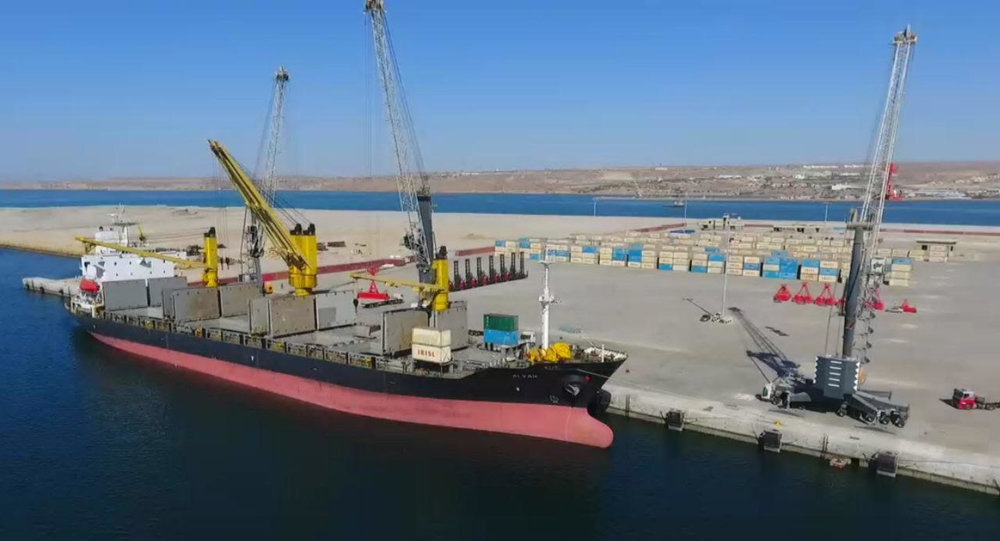Washington may be ratcheting up the pressure on Tehran, but officials in New Delhi do not seem to mind. While the U.S. is pressuring India to reduce trade and commercial links with Iran, ministers recently discussed ways to do just the opposite and find ways to boost trade and investment.
In a meeting with the Iranian Minister of Roads and Urban Development, Abbas Akhoundi, in New Delhi last week, India’s Commerce and Industry Minister, Suresh Prabhu, proposed to double trade with Iran in the next five years, from the current level of $13.8 billion.
Earlier, it was planned that Prabhu would visit Tehran to attend the ministerial meeting of the International North-South Transport Corridor on October 2, but this has been postponed for unknown reasons.
The Iranian minister was in India to participate in the Mobility Summit by the Indian government's think-tank on policy planning.
“Now, we are ready just to hand over the port (Chabahar) to the Indian company just to operate this in interim agreement that already we had with Indian part for one and a half year,” Akhoundi said, according to Indian Express.
The Chabahar port, located in the Iranian southeastern province of Sistan and Baluchestan, is easily accessible from India’s western coast and is increasingly seen as a counter to Pakistan’s Gwadar Port, located just 80 kms from Chabahar. The port is seriously being considered by India as a gateway to trade opportunities in Central Asia and Afghanistan. India will equip and operate two berths in Chabahar Port’s Phase-I, with a capital investment of $85.21 million and an annual revenue expenditure of $22.95 million on a 10-year lease.
After the recent meeting, Prabhu tweeted on his official account on September 7, “Our discussions were centered on expanding bilateral ties between India and Iran beyond the energy and security sector.”
The meeting comes at a time when the U.S. is ramping up sanctions on Iran, after President Donald Trump announced in May that it would be pulling out of the Joint Comprehensive Plan of Action, better known as the nuclear deal. The U.S. has since warned India and other countries to cut oil imports from Iran to zero by November 4, when sanctions go into full effect, or face the consequences.
A source who did not wish to be identified told New Indian Express on Tuesday that India's state-run Bharat Petroleum Corp. will skip its usual purchase of Iranian oil in October due to turnaround at its plants. However, the refiner will lift one million barrels of Iranian oil this month, the source added.
Meanwhile, the president of Federation of Indian Export Organizations, Ganesh Gupta, recently said the government needs to look into problems facing exporters shipping consignments to Iran in view of the sanctions.
On September 3, Reuters reported that Indian state oil refineries will be able to sidestep U.S. sanctions and continue to import Iranian crude oil in a scheme in which buyers shift to using vessels owned by the National Iranian Tanker Co and are insured by Tehran. The news comes after country’s top shipper Shipping Corp of India halted voyages to Iran due to U.S. restrictions.
Iran is India’s third-largest oil supplier after Iraq and Saudi Arabia. Iran supplied 18.4 million tons of crude oil between April 2017 and January 2018.
Trade between India and Iran increased to $13.8 billion in 2017-2018 from $12.9 billion in the previous fiscal. However, India exports goods worth only $2.65 billion to Iran, while its imports stood at $11.11 billion.







 President Ilham Aliyev shed light on the evolving contours of the peace process with Armenia during an international conference in Baku this week. ...
President Ilham Aliyev shed light on the evolving contours of the peace process with Armenia during an international conference in Baku this week. ...
 Azerbaijan and Armenia started the process of demarcation of their border on Tuesday, with the installation of the first border markers based on ge...
Azerbaijan and Armenia started the process of demarcation of their border on Tuesday, with the installation of the first border markers based on ge...
 Armenian sappers commenced on Monday mine-clearance operations in the territories adjacent to the Saint Mary Church in village of Voskepar (Armenia...
Armenian sappers commenced on Monday mine-clearance operations in the territories adjacent to the Saint Mary Church in village of Voskepar (Armenia...
 As the conflict between Ukraine and Russia escalates, the strategic importance of Kharkiv, Ukraine's second-largest city, has come sharply into focus.
As the conflict between Ukraine and Russia escalates, the strategic importance of Kharkiv, Ukraine's second-largest city, has come sharply into focus.
 President Aliyev emphasized the critical role of the North-South Transport Corridor in fostering transport cooperation between Azerbaijan and Russi...
President Aliyev emphasized the critical role of the North-South Transport Corridor in fostering transport cooperation between Azerbaijan and Russi...



